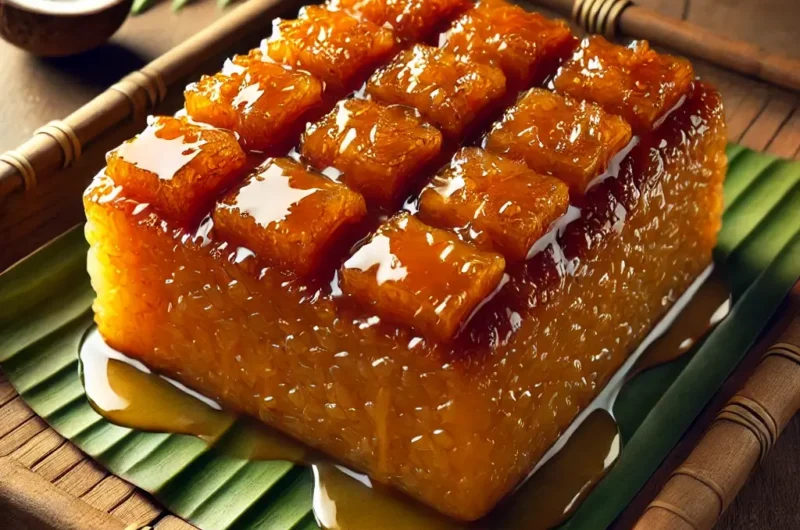Biko: The Beloved Filipino Sticky Rice Dessert You Need to Try
If you’re looking for a dessert that’s both rich in flavor and steeped in tradition, Biko – a classic Filipino sticky rice cake – is a must-try. Made with glutinous rice, coconut milk, and brown sugar, this dish is a staple at Filipino gatherings and celebrations, loved for its chewy texture and caramelized sweetness.
What is Biko?
Biko (pronounced bee-koh) is a popular Filipino kakanin (rice-based delicacy), typically served during fiestas, holidays, and family milestones. The dish is known for its golden-brown, glossy top, achieved by cooking coconut milk and sugar into a thick syrup called latik, which is sometimes drizzled or spread on top.
Biko’s unique appeal lies in its simplicity and bold flavors — a perfect harmony of sweetness from brown sugar, creaminess from coconut milk, and the comforting bite of sticky rice.
Biko Recipe (2 Servings)
Ingredients:
- 1 cup glutinous rice (malagkit)
- 1 cup coconut milk
- ¾ cup brown sugar
- ¼ teaspoon salt
- Optional: Latik (fried coconut curds) for topping
Instructions:
- Cook the Rice: Rinse glutinous rice until water runs clear. Simmer in 1 cup water until mostly absorbed (approx. 10 mins).
- Prepare Coconut Mixture: In a pan, mix coconut milk, brown sugar, and salt. Simmer until sugar is dissolved.
- Combine: Add cooked rice into the coconut mixture. Stir over medium-low heat until thick and sticky (15–20 mins).
- Set and Serve: Transfer to a greased pan, flatten, and optionally drizzle with latik. Let cool before slicing.
Cultural Significance
Biko is more than just a dessert — it symbolizes Filipino hospitality and shared joy. It’s often prepared during New Year’s Eve for good fortune, symbolizing togetherness and prosperity thanks to its sticky nature.
Tips for Perfect Biko
- Use real glutinous rice, not regular rice – it’s key to achieving that iconic chewy texture.
- For a richer taste, caramelize the brown sugar before adding the coconut milk.
- Serve on banana leaves for authenticity and aroma.
Serving Suggestions
Pair Biko with salabat (ginger tea) or barako coffee for a truly Filipino snack experience. Or enjoy it warm with a scoop of coconut ice cream for a fusion twist.
Whether you’re exploring Filipino cuisine or craving a comforting dessert, Biko offers a taste of tradition in every bite. Its simplicity, warmth, and rich history make it a dish to remember — and to share.
Biko (Filipino Sticky Rice Cake)
Course: DessertCuisine: FilipinoDifficulty: Easy2
servings10
minutes35
minutes380
kcalIngredients
1 cup glutinous rice (malagkit)
1 cup coconut milk
¾ cup brown sugar
¼ teaspoon salt
Optional topping: Latik (fried coconut milk curds)
Directions
- Cook the Rice: Rinse glutinous rice until water runs clear. In a pot, combine rice with 1 cup water. Cook over medium heat until water is mostly absorbed (about 10 minutes).
- Make Coconut Mixture: In a separate pan, combine coconut milk, brown sugar, and salt. Stir until sugar dissolves and mixture starts to simmer.
- Combine & Cook: Add cooked rice into the coconut mixture. Stir continuously over medium-low heat until rice thickens and becomes sticky (about 15–20 mins).
- Shape & Set: Transfer mixture into a lightly greased pan. Flatten with a spatula.
- Optional Topping: Drizzle with latik or extra caramelized coconut milk. Cool before slicing into squares.
Notes
- Biko Bites: Cut into small cubes, dip in chocolate, and refrigerate for a twist!
- Toasted Biko: Pan-fry slices in butter for a crispy caramelized edge.
- Biko with Ice Cream: Serve warm with coconut or vanilla ice cream for a fusion dessert.
Why is my biko turning out too hard or dry?
This usually happens if there isn’t enough liquid or if it’s been cooked too long. To get that perfect sticky, moist texture, make sure you use the right ratio of glutinous rice to coconut milk and don’t overcook it. The rice should be soft, sticky, and slightly wet before you take it off the heat.
Can I make biko without coconut milk?
Coconut milk is a key ingredient in traditional biko, giving it its signature taste and creamy texture. You could try using regular milk with a bit of coconut extract, but it won’t have the same authentic flavor.
Why did my biko topping turn grainy or crystallized?
If the sugar in the topping crystallizes, it’s usually because it was stirred while cooling or cooked for too long. To prevent this, avoid mixing it after spreading it on the rice, and cook it just until it thickens—overcooking can cause sugar crystals to form.
Is biko gluten-free?
Yes! Since it’s made with glutinous rice and coconut milk, traditional biko is naturally gluten-free, making it a great option for those with gluten sensitivity or celiac disease.
How do I know when the rice mixture is fully cooked?
You’ll know your biko is ready when the mixture thickens and pulls away from the sides of the pot as you stir. The rice grains should be fully cooked, turning translucent rather than staying white and opaque.







